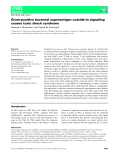
Fever and rash
-
Gynura procumbens (Lour.) Merr. (Family: Asteraceae) is mainly popular in SouthEast Asian countries for its traditional medicinal properties. It is usually used as a traditional medicine for the treatment of eruptive fevers, rash, kidney disease, migraines, constipation, hypertension, diabetes mellitus, and cancer. It is commonly used as a traditional medicine in Vietnam for the treatment of many diseases.
 9p
9p  larachdumlanat127
larachdumlanat127
 02-01-2021
02-01-2021
 5
5
 1
1
 Download
Download
-
Staphylococcus aureusand Streptococcus pyogenes(group A streptococci) are Gram-positive pathogens capable of producing a variety of bacterial exo-toxins known as superantigens. Superantigens interact with antigen-present-ing cells (APCs) and T cells to induce T cell proliferation and massive cytokine production, which leads to fever, rash, capillary leak and subse-quent hypotension, the major symptoms of toxic shock syndrome.
 19p
19p  cosis54
cosis54
 04-01-2013
04-01-2013
 34
34
 3
3
 Download
Download
-
Metabolic and Inflammatory Disorders Acute febrile illnesses may result in vascular damage. This can result from immune complexes containing viral antigens or the viruses themselves. Certain pathogens, such as the rickettsiae causing Rocky Mountain spotted fever, replicate in endothelial cells and damage them. Vascular purpura may occur in patients with polyclonal gammopathies but more commonly in those with monoclonal gammopathies, including Waldenstrom's macroglobulinemia, multiple myeloma, and cryoglobulinemia.
 5p
5p  thanhongan
thanhongan
 07-12-2010
07-12-2010
 67
67
 3
3
 Download
Download
-
In any FUO workup, the erythrocyte sedimentation rate (ESR) should be determined. Striking elevation of the ESR and anemia of chronic disease are frequently seen in association with giant-cell arteritis or polymyalgia rheumatica—common causes of FUO in patients 50 years of age. Still's disease is suggested by elevations of ESR, leukocytosis, and anemia and is often accompanied by arthralgias, polyserositis (pleuritis, pericarditis), lymphadenopathy, splenomegaly, and rash.
 5p
5p  ongxaemnumber1
ongxaemnumber1
 29-11-2010
29-11-2010
 71
71
 3
3
 Download
Download
-
Confluent Desquamative Erythemas These eruptions consist of diffuse erythema frequently followed by desquamation. The eruptions caused by group A Streptococcus or Staphylococcus aureus are toxin mediated. Scarlet fever (Chap. 130) usually follows pharyngitis; patients have a facial flush, a "strawberry" tongue, and accentuated petechiae in body folds (Pastia's lines). Kawasaki disease (Chaps. 54 and 319) presents in the pediatric population as fissuring of the lips, a strawberry tongue, conjunctivitis, adenopathy, and sometimes cardiac abnormalities.
 6p
6p  ongxaemnumber1
ongxaemnumber1
 29-11-2010
29-11-2010
 74
74
 3
3
 Download
Download
-
Centrally Distributed Maculopapular Eruptions Centrally distributed rashes, in which lesions are primarily truncal, are the most common type of eruption. The rash of rubeola (measles) starts at the hairline 2–3 days into the illness and moves down the body, sparing the palms and soles (Chap. 185). It begins as discrete erythematous lesions, which become confluent as the rash spreads. Koplik's spots (1- to 2-mm white or bluish lesions with an erythematous halo on the buccal mucosa) are pathognomonic for measles and are generally seen during the first 2 days of symptoms.
 5p
5p  ongxaemnumber1
ongxaemnumber1
 29-11-2010
29-11-2010
 76
76
 4
4
 Download
Download
CHỦ ĐỀ BẠN MUỐN TÌM


















